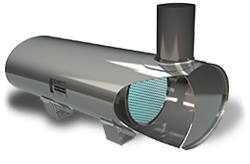Check our 3-Way Catalytic Converters designed especially for gasoline and gaseous LSI and SSI engines
How Clean Are LPG Engines?
LPG was introduced to the market as a "clean-burning" fuel. Is it still clean today, many years down the road? LPG definitely had the potential to become a clean fuel. The reasons for the superior emissions performance were the following:
- Reduced emissions of carbon monoxide compared to gasoline engines (but not as low as in diesel engines).
- No heavy hydrocarbon emissions. HC which are emitted, are of short carbon chain and low ozone-forming reactivity.
- Low emission of toxic air contaminants such as benzene and 1,3-butadiene.
- Low cold-start emissions.
- Likely better emissions durability than that of gasoline engines. LPG emissions should not increase as dramatically with the engine wear and deposit build-up.
- Zero evaporative and running losses due to the sealed fuel system.
For a variety of reasons LPG is not considered the alternative fuel of the future any more. Its place has been taken by natural gas competing with diesel and biodiesel. Consequently, there has been little development in dedicated LPG engine technology. On the other hand, gasoline engines and their emissions improved tremendously over the last decade. As a result of that development, some of the used-to-be advantages of LPG fuel, especially the low CO emissions, are now less pronounced.
Essentially all LPG engines are gasoline engine conversions. As such, they are not engineered to take advantage of the low emission potential of LPG. Their engine/fuel control system is not optimally calibrated for the new fuel, often sacrificing performance, fuel economy, and emissions. The performance and emissions vary between different engines and conversion kits. Electronic LPG conversion kits are available now which should provide the lowest emissions and best fuel economy, but little data exists so far to verify that statement. Many of the mechanical conversions produce engines not even remotely resembling the ideal, low-emission LPG picture. It is wise to request emission data from the vendor when buying an LPG vehicle for indoor application. Unfortunately, brand new LPG conversions emitting CO levels of 2 to 4% are not uncommon. As a generous guideline, an acceptable LPG engine should have exhaust CO concentration of less than 1% under any steady-state condition.
Emissions from LPG engines depend also heavily on engine tune-up. An example plot illustrating the CO levels for different air to fuel ratios is shown in Figure 4. Carbon monoxide emissions skyrocket when the mixture becomes rich. The importance of proper engine tune-up and maintenance for low emissions can not be overestimated.
 Figure 4. Sensitivity of LPG Emissions to A/F Ratio
Figure 4. Sensitivity of LPG Emissions to A/F Ratio
Nett Technologies’ 3-Way Catalytic Converters

Request A Quote
Photo Gallery

